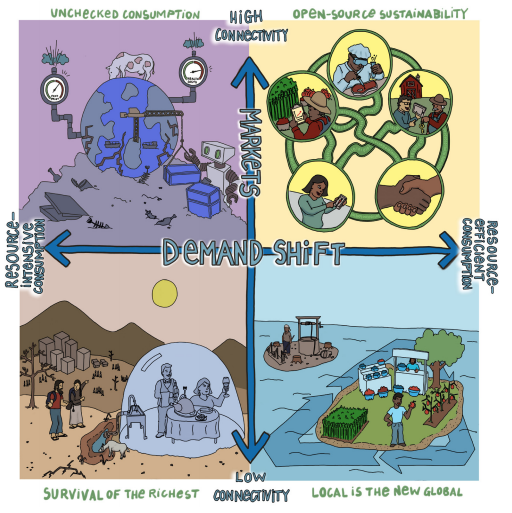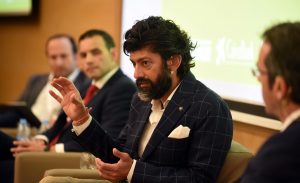Last week IESE Business School held its annual conference on the food industry and I had the pleasure of moderating a session on future scenarios. The session’s speaker was Shay Eliaz from Monitor Deloitte and he had prepared the scenarios for the World Economic Forum and presented them at Davos last year.
The full report can be found here but I will lay out some of the overall themes as well as a project which I think is an interesting example of where all of this is going below.
The organizers of the event asked me to moderate the session because they know that I believe that the future is fundamentally uncertain and that the best way to think about it is to develop alternative scenarios rather than try to forecast what is essentially unknowable. This is, I believe, true in environmental sustainability as well as in geo-politics and a number of other global trends including advances in digitalization, robotics, and artificial intelligence.
 The Monitor methodology is to pick two key trends or drivers, as they are sometimes called and then to look at the four possible realities that emerge form the analysis. The overall idea is shown in the figure to the right.
The Monitor methodology is to pick two key trends or drivers, as they are sometimes called and then to look at the four possible realities that emerge form the analysis. The overall idea is shown in the figure to the right.
The two drivers that Shay and his colleagues looked at were how open or connected the world’s markets would be on the one hand and how resource efficient is the agricultural system on the other.
The time frame of the analysis is 2030.
In their study they combined political connectivity with digital and social connectivity and essentially looked at an open or a closed world. Certainly some of the populist politics we are seeing in different parts of the world would lead us to think about how it appears to be closing but in the context of the next 12 years, things could go back the other way.
In terms of resource use, the other important aspect of the study is that it takes a systemic view of food production and consumption looking across all aspects of the supply chain. The issue is will the system become more aligned with the real constraints of the planet over time or go the other way. In this regard there are enormous gains to be made through innovation going from wide scale use of Israeli drip irrigation to even more sophisticated crop technology which combines agricultural innovation at the crop or even the genetic level as well as the use of advanced digital technology to give each field, or even each plant and animal, exactly the water and nutrients it needs.
The power of scenarios is that it provides food for thought (pun intended) at different levels. At the level of public policy and politics, scenarios can help stimulate the debate as it is clear that civil society may choose the scenario called “Open Source Sustainability” over “Survival of the Richest”. The issue is if we can argue for and get through legislation and agreements at the national and international which will get us there.
At the corporate level, scenarios can be used to think through what the implications of each of the different futures would be on a specific company, operating in specific markets and in a specific part of the value chain. The strategic question has to do with how robust the strategy is in the different scenarios and if the company should make investments today to prepare for different tomorrows.
At a personal or individual level, scenarios such like this can help us make choices in terms of where we want to live and how to prepare ourselves and our families for the world we believe might play out in the future.
Fruit Fal

An example of someone who is working hard to make the future happen is my former student Viresh Prashar who also spoke at the conference and completed the Gobal Executive MBA in 2009.
Viresh and his partners have launched a business in India called Fruitfal which connects local vegetable shops with upscale Indian consumers with a fruit and vegetable app.
While the web site does not give too much information, the business model is compelling and has a very strong sustainability focus. As it reaches scale, Fruitfal will be able to allow these mom and pop retailers to survive against big box stores and on-line giants, reduce food waste (the algorithm can help predict demand and optimize ordering) and also work upstream in the system helping small farmers break the cycle of crushing debt.
Perhaps the most compelling use of scenarios is to go out and make things happen which will move the world in the a positive direction!


Thanks for moderating, it was an excellent session!
Maybe we can plan a new and specific session to keep working on these alternative scenarios and the possible strategies and decisions to be taken in each of them.
Very interesting article!
There are a lot of recurses about food, we only need to find out the right way to share them.